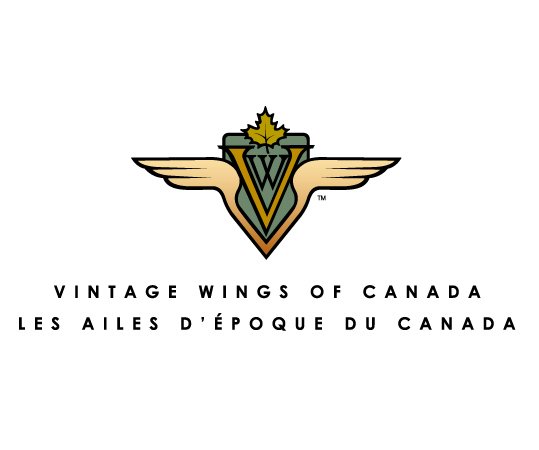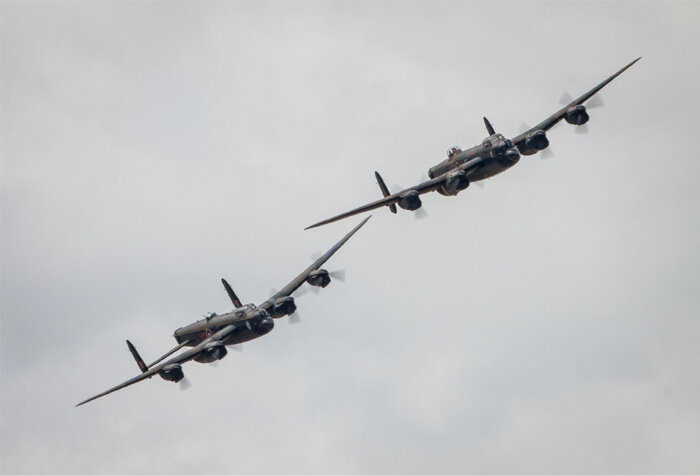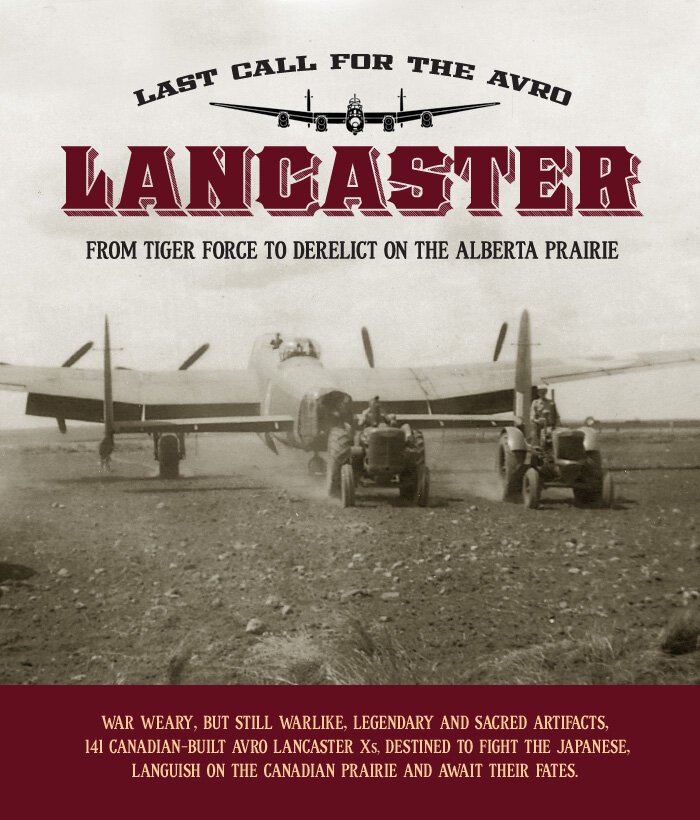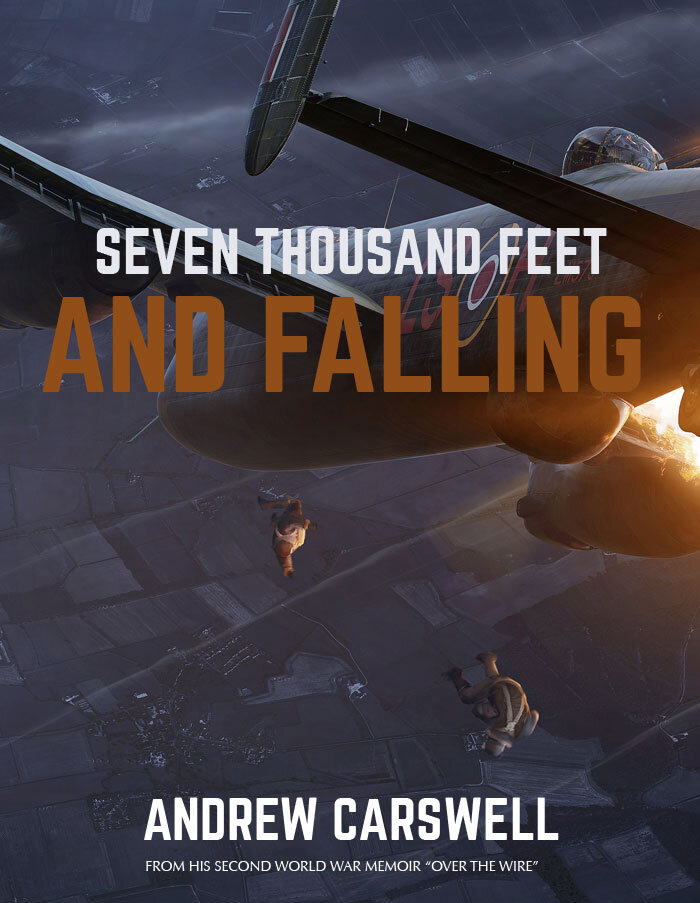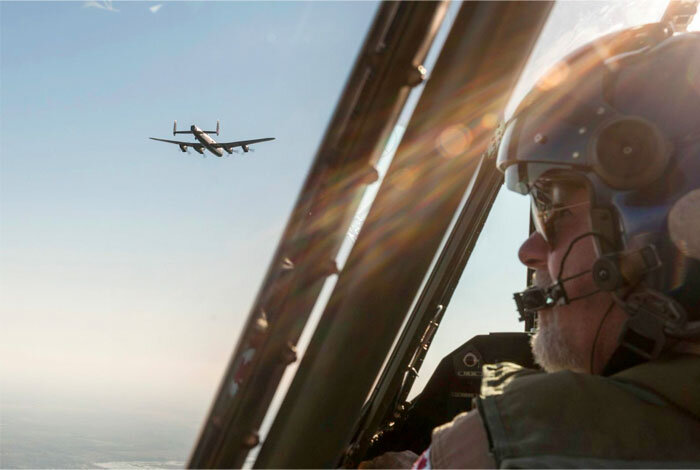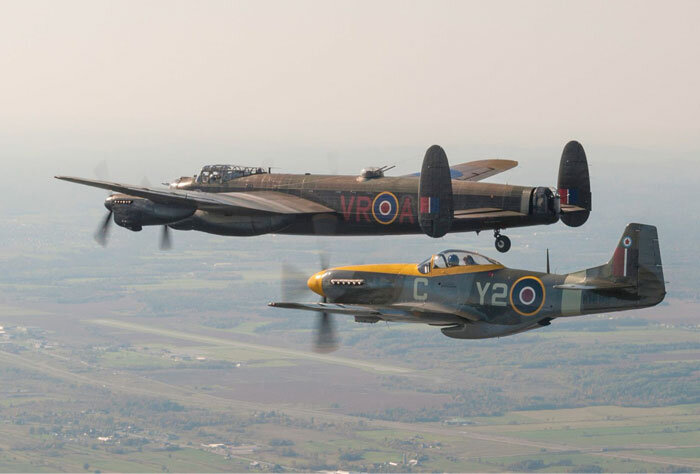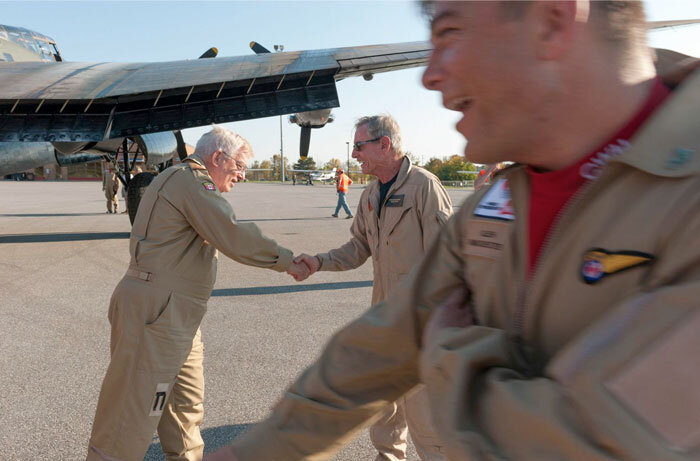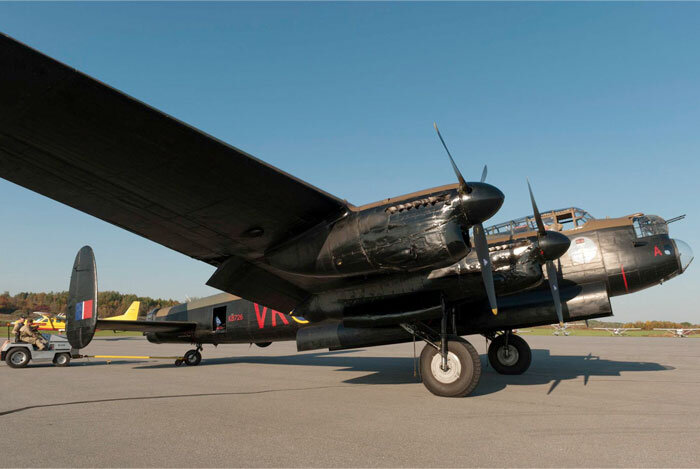THUNDER AND TRIUMPH
This past summer, something happened in the warbird world that has not happened in more than fifty years, something so creative, so daring and so anticipated, it eclipsed all other warbird activity on the planet. Someone, and I am not sure who, at Canadian Warplane Heritage Museum in Hamilton, Ontario had the daring and electric idea to prepare the museum’s much-loved Andrew Mynarski Avro Lancaster and fly it by the old wartime route (Toronto-Gander-Greenland-Iceland-Scotland) to Great Britain and there to join the only other flyable Lancaster in the world to delight and thrill Brits of every age.
It took incredible planning and coordination with the Royal Air Force’s Battle of Britain Memorial Flight (BBMF), the operator of the other Lancaster, to execute a nearly flawless yet hectic schedule of appearances. Led by CWHM’s President, Dave Rohrer, the volunteers at the big museum in Hamilton put together a program that brought the British to their knees with emotion and gratitude.
It’s not that the citizens of Great Britain haven’t seen or heard a Lancaster in all these years since the Lancs were still operational. The BBMF annually thrills the population across Great Britain with powerfully emotional flypasts at air shows and Royal anniversaries. But, seventy years ago, the people of England saw, or rather heard, hundreds of Lancasters and Halifaxes rising above dozens of airfields across England, forming up and heading to the “bomber stream”, that sometimes 100 mile long-five mile wide river of layered four-engined bombers heading to Germany and other targets in occupied Europe to unleash cataclysm. Those thundering, throaty, roaring, angry yet hopeful sounds combined in the night sky to become the fury of the gods. Those sounds were, on many nights, the last vestigial traces of young lives extinguished. For the people of Britain, those sounds became memories of profound depth, sonic symbols of abject sadness, thundering banners of triumph and victory.
For the people of Great Britain, to see and hear more than one of these magnificent aircraft in the sky would be the last opportunity, likely for the rest of their lives. To see two flying together (and another on the ground taxiing), two winging toward victory once again, fanned long dimmed embers of national pride and sorrow. The two together, with their mighty engines pounding with pride, ghosted across England and Scotland, to visit the old places, the old memories, the old friends, from Beachy Head to the Derwent Dam. Everywhere the two went, the roads were jammed with traffic, the spectators crowded the flight line, tears streaming. Many came to see the second Lanc, one they had never seen before, but the true beauty of the experience was the sight of two together, the sound of eight engines, and the smell of victory.
Vintage Wings of Canada had the honour this last weekend of escorting the CWHM Lancaster around the Nation’s Capital at the end of the long penultimate leg of a months’ long journey. Mike Potter wanted to welcome them home in a powerful way, so he took the VWC P-51 Mustang, dedicated to RCAF fighter pilots Larry and Rocky Robillard, along with the Curtiss P-40 Kittyhawk, dedicated to Wing Commander Stocky Edwards, into the sky and headed east to meet the Lancaster as she steamed westward into the fast-dropping late afternoon sun of a perfect fall day. Each of the two aircraft carried a photographer in the back seat to record the event. After rendezvous, the Lancaster led the formation on two circuits of the city and landed to the applause of hundreds at the Vintage Wings hangar.
The CWHM's Mynarski Lancaster (left) follows the BBMF Lanc at the Little Gransden Children in Need Airshow. Photos: Harry Measures
Vintage Wings of Canada congratulates the volunteers of the Canadian Warplane Heritage Museum for their daring, their creativity, and yes, their courage for a feat of airmanship not witnessed in the warbird world for many a year. They took Great Britain by storm, and made us proud to be their friends and colleagues. The team at the CWHM is comprised not of paid air force pilots but volunteers with thousands upon thousands of hours of experience. It is highly unlikely that the trip will be reciprocated by the BBMF, as the visceral emotions fuelled by the sight of a Lancaster are more powerful and more concentrated in Great Britain, a much smaller country, upon which wartime Lancasters operated and often went to their doom. They feel it there like no other country on the face of the Earth. Also, the Royal Air Force is much encumbered by budgets and cannot make such a decision. That being said, both operators have gained much by this summer’s flying activity and we are all proud on both sides of the big pond.
Here, for your enjoyment, is a photo record of the honour we were granted to welcome our friends back home. Thanks to photographers Peter Handley, Darren Brown and Pierre Lapprand
Rob Erdos communicates that he is winding up the starter by rotating his finger in the air, prior to starting the 12-cylinder Allison engine of the Curtiss P-40N Kittyhawk. Photo: Peter Handley
Mike Potter lines up with Erdos at the end of the Gatineau runway, waiting for him to start his takeoff roll. Photo: Darren Brown, Ottawa Citizen
Related Stories
Click on image
Climbing out from Gatineau, Erdos searches for his wing man, taking off from Vintage Wings’ home airfield. Photo: Peter Handley
En route to rendezvous with the Lancaster east of Gatineau, Mike Potter in the Robillard Brothers P-51 Mustang slides into the right wing of Erdos’ Kittyhawk. Photo: Peter Handley
From the vantage point of the Mustang, Ottawa Citizen photographer Darren Brown captures his lead. Photo: Darren Brown, Ottawa Citizen
Circling above the Ottawa River Valley with the village of Montebello, Québec in the background. Photo: Peter Handley
Mike Potter moves to Erdos’ left wing in preparation for meeting up with the Lancaster. Photo: Peter Handley
Erdos and Potter split up to join the Lancaster on either side as she heads towards the cities of Gatineau and Ottawa. Photo: Peter Handley
Sliding down the Ottawa River Valley to the north of the river, the three aircraft are inbound for Ottawa. Photo: Peter Handley
From the left wing, Brown captures the distinctive silhouettes of the Kittyhawk and the Lancaster. Photo: Darren Brown, Ottawa Citizen
The Lanc leads the flight along the Ottawa River near the Québec town of Masson-Angers, just a few kilometres from the Gatineau Airport. Photo: Darren Brown, Ottawa Citizen
From the back seat of the Kittyhawk, Peter Handley asks for a crossover to get a few photos of the other side with the Mustang. Erdos obliges with a slide under the Lancaster (all briefed beforehand of course). Photo: Peter Handley
Erdos slides across to Potter’s left wing for an echelon-left formation photo. Photo: Peter Handley
A beautiful shot of the Robillard Brothers Mustang flying in escort of the Mynarski Lancaster—two old friends who have flown a lot together over the past decade. Photo: Peter Handley
Back on the other side, Erdos snugs up close to the Canadian Warplane Heritage Museum’s Mynarski Lancaster as it runs down the Ottawa River after having flown from Newfoundland and after having previously crossed the North Atlantic. Photo: Peter Handley
The Mynarski Lancaster crosses downtown Ottawa to the south of the Parliament Buildings (the green roofed building just visible beneath her tail wheel is not part the Parliament Buildings, but rather the Confederation Buildings). The British took to calling her VeRA for her aircraft and squadron code VR-A (VR was the squadron code for 419 Moose Squadron, Royal Canadian Air Force). For us, she is the Mynarski Lanc. Photo: Darren Brown, Ottawa Citizen
Having crossed the city of Ottawa from east to west, The Lancaster and her escort execute a wide right-hand turn over a widening of the Ottawa River known as Lac Deschênes to bring them back over the city. It was a perfect day for sailing on this day, but made all the better by this display of historic aircraft and their triumphant thunder. Photo: Darren Brown, Ottawa Citizen
Having made the turn at Lac Deschênes, The CWHM Mynarski Lancaster leads the team right back across the city. The flight flew directly across my home, leading my neighbours to ask if they were flying over at my request... a rumour I did little to disclaim. Photo: Peter Handley
The Mynarski Lancaster flies over Ottawa with the Parliament Buildings directly below her aft fuselage. It was here in 1942 that the Government of Canada created a crown corporation known as Victory Aircraft and expropriated the factories of National Steel Car (NSC) at Malton, Ontario. The government was worried about the production capabilities of NSC and its ability to meet demand for Lancasters. Once Victory Aircraft was set up at Malton, they built 430 Avro Lancaster Xs including RCAF Lancaster FM213, the Mynarski Lancaster. Photo: Peter Handley
After her second pass of downtown Ottawa, the Lancaster turns and heads toward a final, full stop landing at Gatineau. Photo: Darren Brown, Ottawa Citizen
Dave Rohrer, the pilot of the CWHM’s Mynarski Lancaster, begins a let down to the Gatineau airfield, home of Vintage Wings of Canada. Photo: Darren Brown, Ottawa Citizen
From the ground at Vintage Wings of Canada, spectators are treated to the thunder of five Merlins and one Allison engine as the three aircraft do one formation pass over the airfield. Photo: Pierre Lapprand
It’s a long way from Scotland to Gatineau, as witnessed by the white exhaust stains streaming back along the engine nacelles as VR-A touches down ever so smoothly on Runway 27 at Gatineau. A beer is gonna taste real good about now. Photo: Pierre Lapprand
The Lanc rolls out, then backtracks Runway 09 to the turnoff for the ramp while visitors machine gun away with their cameras. Photo: Pierre Lapprand
Following the Lancaster’s landing at Gatineau, Erdos turns base leg heading to join up with the Lanc, now backtracking down the runway and to the ramp of the airport terminal building. Photo: Peter Handley
Mike Potter executes a dramatic topside pass down the runway in salute of the accomplishment of the crew of the Mynarski Lancaster. Photo: Pierre Lapprand
The Lanc’s pilots trundle the big bomber along the taxiway to the airport ramp where she will be hooked up and towed to the Vintage Wings ramp. Photo: Pierre Lapprand
Standing in the weeds along a drainage ditch, Lapprand shoots a nice photo of the Lanc in the low autumn light on as it prepares to shut down. Photo: Pierre Lapprand
The Wing Commander Stocky Edwards P-40 Kittyhawk recovers, with photographer Handley beaming in the back seat. Along the rising hills behind the Gatineau runway, the trees begin their full fall colour riot. Photo: Pierre Lapprand
Mike Potter in the Robillard Brothers Mustang rolls out after yet another successful mission to escort a Canadian Warplane Heritage Museum aircraft. Photo: Pierre Lapprand
Down on the ground, Mike Potter grabs the Vintage Wings Jeep and heads to the airport ramp to greet the weary aviators. Photo: Peter Handley
Rob Erdos, Kittyhawk pilot, greets Lancaster pilot Don Schofield as the crew deplanes. Photo: Peter Handley
In the foreground, a beaming Lancaster crewman, Glen Manchester, smiles widely and shakes Erdos’ hand as Mike Potter greets Schofield after their history making journey to the UK. Photo: Peter Handley
Dave Rohrer, Lancaster pilot and President of the Canadian Warplane Heritage Museum, and Mike Potter, Mustang Pilot and founder of Vintage Wings of Canada, speak to reporters. Photo: Peter Handley
Vintage Wings mechanics hook up the tail of the Lancaster for a tow over to the VW ramp. Photo: Peter Handley
The VW mule pulls the Lancaster on to the ramp. Photo: Peter Handley
Mike Potter gives some of the crew a lift to the ramp. Photo: Peter Handley
As the engines finally cool down to ambient temperature, the crowd gathers round to inspect the conquering Lancaster. Photo: Peter Handley
The photographer’s two-and-half-year-old daughter meets a new friend at the Vintage Wings ramp and they race towards the 70-year-old Lancaster. Photo: Peter Handley
Vintage Wings of Canada opened its doors to visitors this day, so that they could get up close and touch and smell history in the making. Photo: Peter Handley
The lead and sulphur found in the high octane avgas stain the Lanc’s engine nacelles, and clearly indicate the hard work they did to get the aircraft from Great Britain to Canada. Photo: Peter Handley
Members of the crew pose with spectators in front of the Mynarski Lanc. Photo: Peter Handley
Her 30-foot bomb bay doors open, the Lancaster makes an impressive sight. The Lanc could out lift the B-17 by a considerable margin and could lift a 12,000 lb. Tall Boy bomb. Photo: Peter Handley
The Lancaster's crew for the flight across the Atlantic was (from second left to right) Dave Rohrer, Glen Manchester, Don Schofield, Craig Brookhouse, Randy Straughan, and Leon Evans. Their feat of airmanship is the equal of wartime ferry pilots, perhaps even greater as the aircraft was 70 years old. At far right is Jeff Cairns, a businessman from St. Catharine's, Ontario, who flew home with the crew after submitting the winning bid for the opportunity. Photo: Peter Handley
Dave Rohrer introduces his crew. Photo: Peter Handley
Rohrer thanks Glen Manchester, who paid for the privilege and trained to be a crew member of the Lancaster for the trip back across the Atlantic. Tropical rocker Jimmy Buffet once said: “You do it for the stories you could tell” and there’s no doubt Manchester has a good story to tell and a memory not many can share. Kudos to him for stepping up to the plate. Photo: Peter Handley
And finally, Rohrer introduces Don Schofield, now the world’s highest time current Lancaster pilot. Photo: Peter Handley

